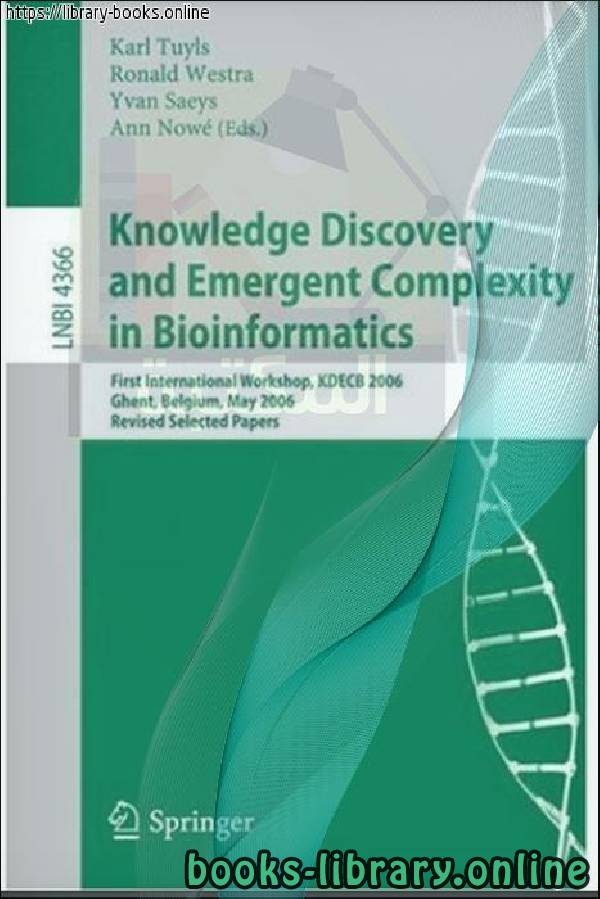📘 قراءة كتاب Lecture Notes in Computer Science أونلاين


Biologically
Biology is a natural science that is concerned with the study of life, its various forms and its function, how these organisms interact with each other and with the surrounding environment. The word biology in Greek is made up of two words: bio (βίος) meaning life. And loggia (-λογία) means science or study. Biology: the similarity of vegetation and animal cover on the edges of the African and American states, and the existence of the same fossil.
Branches of biology
Biology is an ancient science thousands of years old and modern biology began in the nineteenth century. This science has multiple branches. Among them are:
Anatomy
Botany
Biochemia
Biogeography
Biofisia
Cytology or cell science
Ecology or environmental science
نبذه عن الكتاب:
This book contains selected and revised papers of the International Symposium on
Knowledge Discovery and Emergent Complexity in Bioinformatics (KDECB 2006),
held at the University of Ghent, Belgium, May 10, 2006.
In February 1943, the Austrian physicist Erwin Schr¨odinger, one of the founding
fathers of quantum mechanics, gave a series of lectures at Trinity College in Dublin
titled “What Is Life? The Physical Aspect of the Living Cell and Mind.” In these lectures Schr¨odinger stressed the fundamental differences encountered between observing
animate and inanimate matter, and advanced some, at the time, audacious hypotheses
about the nature and molecular structure of genes, some ten years before the discoveries
of Watson and Crick. Indeed, the rules of living matter, from the molecular level to the
level of supraorganic flocking behavior, seem to violate the simple basic interactions
found between fundamental particles as electrons and protons. It is as if the organic
molecules in the cell ‘know’ that they are alive. Despite all external stochastic fluctuations and chaos, process and additive noise, this machinery has been ticking for at least
3.8 billion years. Yet, we may safely assume that the laws that govern physics also steer
these complex associations of synchronous and seemingly intentional dynamics in the
cell. Contrary to the few simple laws that govern the interactions between the few really
elementary particles, there are at least tens of thousands of different genes and proteins,
with millions of possible interactions, and each of these interactions obeys its own peculiarities. There are different processes involved such as transcription, translation and
subsequent folding. How can we ever understand the fundamentals of these complex
interactions that emerge from the few empirical observations we are able to make?
Biology
Human biology
Who is the founder of biology?
The importance of biology
Areas of work in the field of biology
Theories of biology
Research on biology for the first grade of secondary school
Human biology
سنة النشر : 2006م / 1427هـ .
حجم الكتاب عند التحميل : 2.53 .
نوع الكتاب : pdf.
عداد القراءة:
اذا اعجبك الكتاب فضلاً اضغط على أعجبني و يمكنك تحميله من هنا:

شكرًا لمساهمتكم
شكراً لمساهمتكم معنا في الإرتقاء بمستوى المكتبة ، يمكنكم االتبليغ عن اخطاء او سوء اختيار للكتب وتصنيفها ومحتواها ، أو كتاب يُمنع نشره ، او محمي بحقوق طبع ونشر ، فضلاً قم بالتبليغ عن الكتاب المُخالف:
 قبل تحميل الكتاب ..
قبل تحميل الكتاب ..
يجب ان يتوفر لديكم برنامج تشغيل وقراءة ملفات pdf
يمكن تحميلة من هنا 'http://get.adobe.com/reader/'


 منصّة المكتبة
منصّة المكتبة 